| Columns Retired Columns & Blogs |
Naim CD5 CD player with Flatcap 2 power supply Measurements
Sidebar 3: Measurements
I mostly measured the CD5's performance with the Flatcap 2 power supply, though I did repeat some of the tests without the external supply powering the analog stages. (I used the Chord Cobra DIN/RCA adapter cables supplied with the CD5.) The Naim's error correction was superb, the player not missing a beat until track 34 of the Pierre Verany Test CD, which has 2mm gaps in its data spiral. Its maximum output level was 0.7dB higher than specified, at 2.171V, and the output was non-inverting. The output impedance was a very low 2.5 ohms across most of the audioband, though this did rise to 465 ohms at 20Hz, presumably due to the coupling capacitor used. This will not be a problem unless a preamplifier is used that has an input impedance significantly lower than 5k ohms, in which the extreme lows will roll off prematurely.
The CD5's frequency response (fig.1, top traces) featured a slight amount of passband ripple and a slightly early HF rolloff, to -0.5dB at 19kHz. The de-emphasis (fig.1, lower traces) featured the same mid- and upper-treble error as the SimAudio Moon Eclipse player, reviewed elsewhere in this issue by Brian Damkroger. Fortunately, pre-emphasized discs are as rare as musical worth on a Kenny G album. Channel separation (not shown) was excellent, at better than 100dB below 2kHz, though capacitive coupling between the channels reduced this to a still-good 75dB at 20kHz.
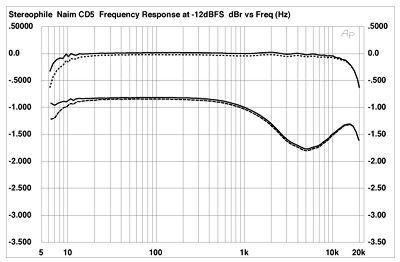
Fig.1 Naim CD5, frequency response at -12dBFS, without emphasis (top) and with emphasis (bottom). (Right channel dashed, 0.5dB/vertical div.)
Spectral analyses of a dithered 1kHz tone at -90dBFS (fig.2) and of "digital black" (fig.3) revealed a commendable absence of power-supply-related spuriae, even without the external supply. Linearity error (fig.4) was very low down to below -100dBFS, but rather more noise was apparent in this graph than is usually seen these days. Nevertheless, the CD5's reproduction of an undithered 1kHz sinewave at -90.31dBFS (fig.5) was excellent, with the three discrete voltage levels clearly evident.
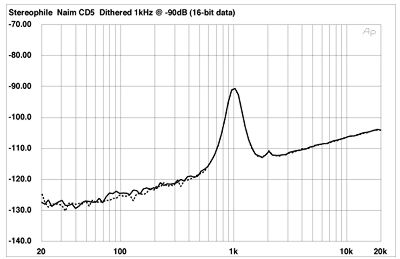
Fig.2 Naim CD5, 1/3-octave spectrum of dithered 1kHz tone at -90dBFS, with noise and spuriae, 16-bit data (right channel dashed).
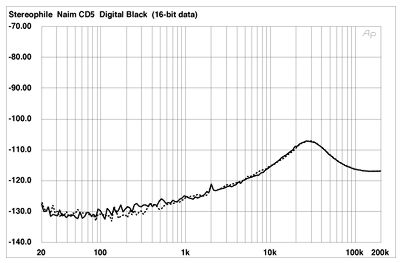
Fig.3 Naim CD5, 1/3-octave spectrum of "digital black" with noise and spuriae, 16-bit data (right channel dashed).
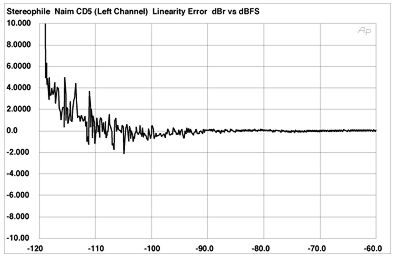
Fig.4 Naim CD5, left-channel departure from linearity, 16-bit data (2dB/vertical div., right channel dashed).
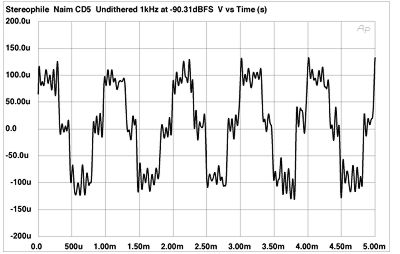
Fig.5 Naim CD5, waveform of undithered 1kHz sinewave at -90.31dBFS, 16-bit data.
Despite its very low source impedance, the Naim was more comfortable driving higher impedances. Figs. 6 and 7, for example, show the spectrum of its output while it drove a full-scale 50Hz sinewave into 100k ohms and 600 ohms, respectively. Into the high impedance, what distortion products there are are both low-order and around the -100dB level. Into 600 ohms, however, both the second and third harmonics rise significantly, although to levels that are still low in absolute terms. More important, the second harmonic has risen more than the third, which tends to minimize the effect of the harmonics on the subjective perception of the sound. In-band intermodulation spuriae (fig.8) are virtually nonexistent, even into lower impedances.
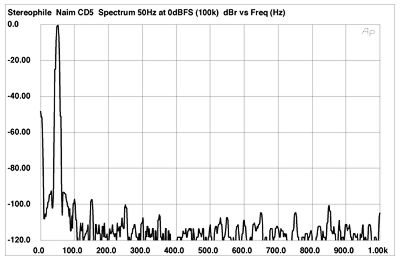
Fig.6 Naim CD5, spectrum of 50Hz sinewave, DC-1kHz, at 0dBFS into 100k ohms (linear frequency scale).
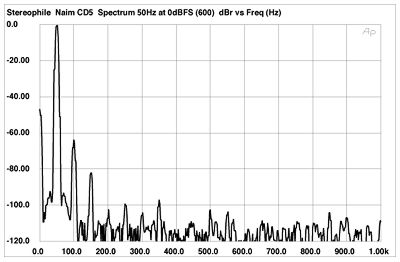
Fig.7 Naim CD5, spectrum of 50Hz sinewave, DC-1kHz, at 0dBFS into 600 ohms (linear frequency scale).
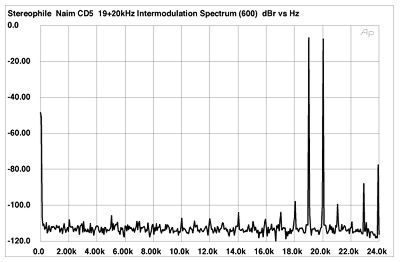
Fig.8 Naim CD5, HF intermodulation spectrum, DC-24kHz, 19+20kHz at 0dBFS into 600 ohms (linear frequency scale).
Using the Miller Audio Research Jitter Analyzer to assess the player's word-clock jitter, I found the CD5 to be an excellent performer in this regard. Without the Flatcap, the peak-peak jitter measured 236 picoseconds, this dropping to 218ps with the external supply. A high-resolution spectrum of the CD5's analog output with its analog stages powered from the Flatcap is shown in fig.9. Data-related jitter (red numeric markers) is very low, and the only jitter-related sidebands of any significance appear at ±649Hz (purple "6"). However, the noise floor is several dB higher than I've come to expect from the best-sounding CD playback systems. There are also a number of discrete noise components present. I did find the CD5 to be susceptible to RF interference from the monitor of my lab-test computer; perhaps that's what we're seeing here.
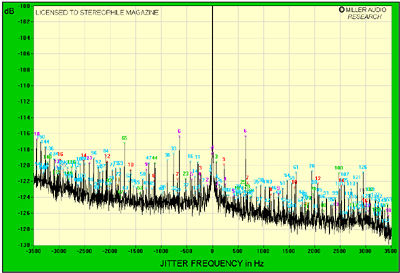
Fig.9 Naim CD5, high-resolution jitter spectrum of analog output signal (11.025kHz at -6dBFS with LSB toggled at 229Hz). Center frequency of trace, 11.025kHz; frequency range, ±3.5kHz.
As well as jitter, the Miller Analyzer measures absolute speed accuracy. Earlier Naim players had run their master clocks a little fast, and the CD5 maintains the tradition with an absolute error of +283 parts per million. However, at just 0.000283%, I suspect that this is not enough to be perceived as an increase in tempo or pitch.—John Atkinson
- Log in or register to post comments



































